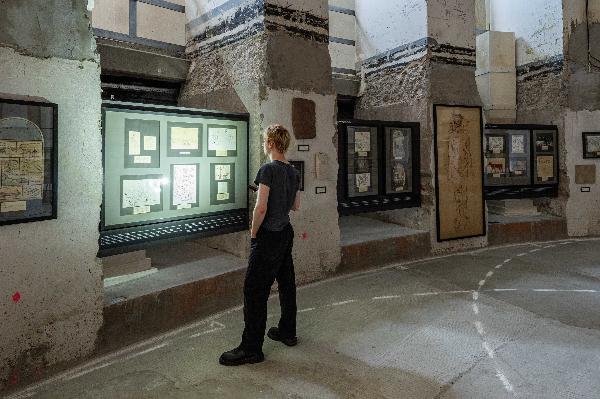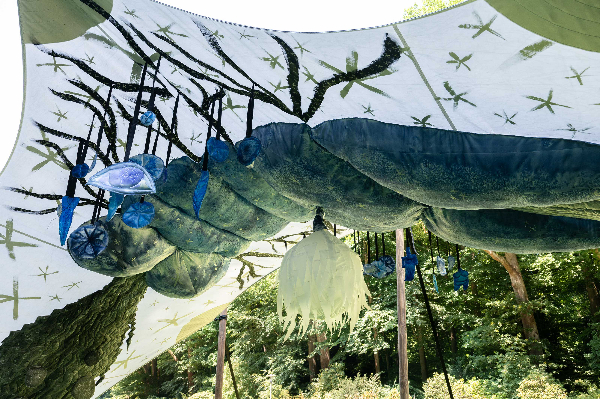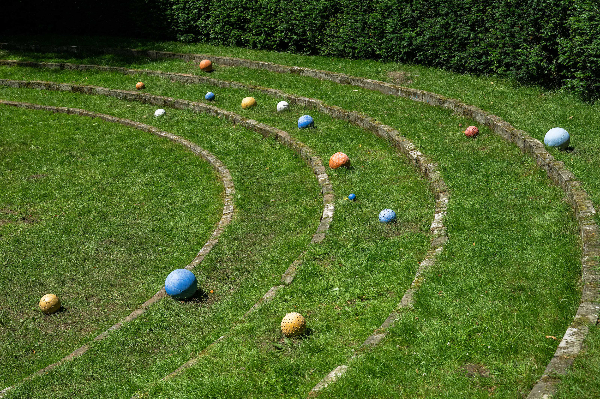As Above, So Below. 'From the Cosmos to the Commons' in Hamburg
Door Pieter Vermeulen , op Fri Aug 22 2025 06:00:00 GMT+0000With art historian Aby Warburg’s Bilderatlas as a starting point, curator Joanna Warsza has set up an exhibition that speaks to the urgencies of today. Art critic Pieter Vermeulen reports from the city of Hamburg: ‘In turbulent times marked by global conflicts, relentless human right violations, political saber-rattling, nuclear tensions, and climate crimes, thinking on a planetary scale feels not only justified but imperative.’
According to my way of experiencing things, any gesture always implied a perturbation, a fragmentation, of the external world; I always feared that any movement on my part would dislodge the stars or alter the skies.
– Fernando Pessoa, The Book of Disquiet
Strolling through Hamburg’s city park, one encounters the Planetarium rising like a mastodon. Among the world’s oldest sky observatories, it is housed in a former Art Deco water tower – a majestic landmark in itself. It was here that art historian Aby Warburg (1866–1929), shortly before his death, curated an exhibition for the Planetarium’s public opening on the intertwined history of astrology and astronomy. This became the only completed chapter of his vast research endeavor Bilderatlas Mnemosyne, which secured him international recognition. Begun in the 1920s and left unfinished, Warburg’s monumental undertaking comprised an immense assemblage of research materials – art historical images, scientific diagrams, postcards, newspaper clippings – meticulously arranged across dozens of wall panels. His aim was to trace the ways images act as emotional, symbolic, and intellectual vectors over time. In today’s image-saturated world, where pictures endlessly migrate across screens, carriers, and platforms, Warburg’s vision feels more prescient than ever.

Warburg’s Collection of Pictures Portraying the History of Belief in the Stars and Astronomy was inaugurated in 1930, placed in storage in 1941 due to the war, briefly reinstalled in 1945, and then again in 1968. The panels were considered lost until their rediscovery in 1987 – found in a pile of trash at the Planetarium. Today they are housed at the University of Hamburg. This strange, interrupted history inspired Joanna Warsza to make it the starting point for her five-year tenure as Hamburg’s city curator. The original exhibition, restaged in close collaboration with Warburg scholar Uwe Fleckner, can be visited on the top floor of the former water tower, using a flashlight provided at the entrance. The reinstallation is carried out with exquisite care. Arranged along elliptical outlines on the floor – an echo of celestial orbits – it allows for close study of the original black-and-white plates, alongside selections from his vast book collection.
In Egyptian belief, Nut swallowed the sun each night only to give birth to it anew at dawn: a cyclical, feminine vision of cosmic order.
Around this nucleus, several contemporary artists have been invited to enter into dialogue with Warburg’s atlas of images, under the title From the Cosmos to the Commons. Projected on the wall, Blood Moon by Raqs Media Collective is a video piece reflecting on the affective pull the moon has on us as human beings, and how its intensity disrupts standardized clock time. Nearby, KITE presents a meticulous geometric arrangement of stones, stemming from the artist’s research into how Indigenous knowledge can inform computational systems. Chilean artist María Edwards’s Constellation of the Commons is a delicate, diorama-like installation composed of objects sourced from Hamburg’s port and surroundings, connected by threads into a three-dimensional web that visitors can walk around.
Warburg coined the term ‘Bilderfahrzeuge’ – ‘image vehicles’ traveling through human history. He valued images less for their material authenticity than for the meanings they carried. One such emblem, included in the present exhibition, is a sarcophagus lid – or a reproduction of it – depicting the Egyptian sky goddess Nut, her body arched in a protective embrace over the dead. The image offers a maternal counterpoint to the more male-dominated cosmologies of ancient Greece, where the heavens were imagined not only as a solid dome over the flat plane of Gaia, but also personified in Uranus – father of the Titans – whose body sprawled across the Earth. In Egyptian belief, Nut swallowed the sun each night only to give birth to it anew at dawn: a cyclical, feminine vision of cosmic order. This is what inspired artist Hoda Tawakol to create her work, Cosmic Womb, visible in the park from the Planetarium’s terrace. It takes the form of a curved, star-strewn canopy, set up like a tent on the grass. Seen up close, it reveals itself as a mesmerizing textile installation honoring the voluptuous, maternal body. Providing shade and shelter on the expansive lawn, the installation transforms after dusk, gently glowing with the solar energy it has gathered throughout the day.

From this vantage point, one can see a zodiac-like belt of five female portraits above the Planetarium’s fountain. They are by Polish artist Małgorzata Mirga-Tas, with whom Joanna Warsza previously collaborated at the Polish Pavilion of the 2022 Venice Biennale. Drawn from Mirga-Tas’s Herstories series, the figures pay tribute to heroines from the Roma community. Her zodiac here echoes the presentation in Venice and draws inspiration from the Renaissance frescoes of the Palazzo Schifanoia in Ferrara. Warburg is never far: a black-and-white reproduction of the Allegory of March from that very palace appears on one of his panels inside the Planetarium. This resonance between past and present produces a palpable pleasure of recognition during the exhibition visit. From the Cosmos to the Commons does not merely invoke Warburg as a mere shortcut or to add intellectual gravitas; it treats him, rather, as a living interlocutor whose ideas still speak to the urgencies of today.
In turbulent times marked by global conflicts, relentless human right violations, political saber-rattling, nuclear tensions, and climate crimes, thinking on a planetary scale feels not only justified but imperative.
Another intervention along the horizontal sweep of the lawn comes from Agnes Denes, a pioneering artist in dealing with ecological issues, thus also touching on the exhibition’s second theme: the commons. Renowned for planting two acres of wheat on a Manhattan landfill near Wall Street in 1982, she raised questions around ownership of land, as well as our shared responsibility toward it. Here, the artist has sown sunflower seeds which, though not yet in bloom at the time of our visit, will soon punctuate the monoculture of grass with vivid color. Facing the planetarium, Denes’s 1969 manifesto is printed on a mirrored surface that reflects the sky above. It contains the striking words: ‘Seeing reality and still being able to dream.’

The true highlight of the open-air section is a work by Belgian artist Heidi Voet. Tucked discreetly into a small, overgrown amphitheater in the park, her installation arranges multicolored balls along its concentric steps. Inspired by the stars – specifically the constellation Hydra, visible above Hamburg’s night sky this summer – Voet chose the colors of the spheres, or their concrete casts, according to the Morgan–Keenan classification system, which categorizes stars by age and temperature. Back on Earth, the work not only resonates with Warburg’s image collection, but also recalls Wittgenstein’s reflections on ‘family resemblances’. In his Philosophical Investigations (1953), he argues that meaning emerges not from a single shared essence but from overlapping similarities – much like the many forms of a ‘game.’ As he writes: ‘Don’t say: “There must be something common, or they would not be called ‘games.’” For if you look at them you will not see something that is common to all, but similarities, relationships, and a whole series of them at that.’ The same, Wittgenstein adds, applies to ball games. In Voet’s amphitheater, the diversity of spheres echoes that thought – part star chart, part playground – linking the ground beneath our feet to the sky above in a quietly joyful meditation on human existence and the ties that connect us.
Warsza’s curatorial vision for her five-year program will revolve around the five classical elements, fundamental to the human imagination: cosmos, fire, air, earth, and water. The current chapter focuses on aether, the fifth element in classical philosophy and alchemy. Her approach, mapping these elements along two axes – the vertical (cosmos) and the horizontal (commons) – is ambitious, even audacious, balancing conceptual boldness with the risk of overreach. Yet in turbulent times marked by global conflicts, relentless human right violations, political saber-rattling, nuclear tensions, and climate crimes, thinking on a planetary scale feels not only justified but imperative.
To see reality and still be able to dream is to insist that reality, above as well as below, can and must be otherwise.
While the exhibition convincingly substantiates its cosmic motifs – thanks in part to Aby Warburg – the concept of the commons is addressed more poetically than critically. This makes the continuation of Warswa’s program worth following. Both themes are widely explored in contemporary art discourse, but it is their intersection that promises real urgency. From the Cosmos to the Commons is at its strongest when it engages the local context and history, connecting not only to Warburg, but also to Hamburg’s fraught process of coming to terms with its past – the ongoing work of Vergangenheitsbewältigung. The city itself provides constant reminders in this respect, such as the massive Hochbunker, a WWII anti-aircraft structure in the district of St. Pauli, recently repurposed into a complex with hotels, restaurants, music venues, and exhibition spaces.
Warsza’s second programmatic pillar, starting in late summer 2025, will turn toward Hamburg’s heritage and public art collection, engaging the phenomenon of counter-monuments. Anchored by the quintessential Monument against Fascism (1986) by Esther Shalev-Gerz and Jochen Gerz, this strand will also involve artists such as Kader Attia and the collective Chto Delat. In times when the ghosts of the past continue to haunt present and future, criticality and imagination are not only artistic or curatorial urgencies, but civic necessities. To see reality and still be able to dream – to recall Agnes Denes once more – is to insist that reality, above as well as below, can and must be otherwise.
From the Cosmos to the Commons, Stadtkuratorin Hamburg, June 20–August 24, 2025, https://stadtkuratorin-hamburg.de/